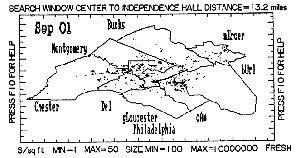 Move, Inc. v. Real Estate Alliance, Dkt No. 2010-1236 (Fed. Cir. Mar. 22, 2011) [PDF].
Move, Inc. v. Real Estate Alliance, Dkt No. 2010-1236 (Fed. Cir. Mar. 22, 2011) [PDF].
Move sued Real Estate Alliance (Real) seeking declaratory judgment that Real’s U.S. Patent No. 4,870,576, and 5,032,989 (the ’989 patent) were invalid. Real appealed the district courts construction of claim 1 of the ‘989 patent. Claim 1 provides:
A method using a computer for locating available real estate properties comprising the steps of:
a) creating a database of the available real estate properties;
b) displaying a map of a desired geographic area;
c) selecting a first area having boundaries within the geographic area;
d) zooming in on the first area of the displayed map to about the boundaries of the first area to display a higher level of detail than the displayed
map;
e) displaying the zoomed first area;
f) selecting a second area having boundaries within the zoomed first area;
g) displaying the second area and a plurality of points within the second area, each point repre-senting the appropriate geographic location of an
available real estate property; and
h) identifying available real estate properties within the database which are located within the second area.
Difference between use of “of” and “for.” The Federal Circuit addressed the construction of several terms and phrases of the claim, however this post will focus on the meaning of the phrase “creating a database of available read estate properties. “Â The district court construed the claim to cover creating only the structure or schema of the database, i.e., creating an empty database with a defined structure. The district court noted that “the plain language of the claim, creating a database ‘of’ properties, rather than ‘for’ properties, implies that the database is populated with properties when its created.” However, the district court reasoned that “that database is not populated by the inventor, but rather by third-party users, who wish to sell a property.”
Federal Circuit. The federal circuit disagreed and found that the use of “of” in the claim requires that in order to infringe, the database must be populated with at least two properties upon creation. In addition the court noted that the pre-existing properties are first mentioned in the preamble and they are displayed in step (g) and identified in step (h). In other words, an empty database would not infringe.
One Reply to “The Difference One Word Makes: “Creating a Database ‘of’ Properties” Required a Prepopulated Database”
Comments are closed.